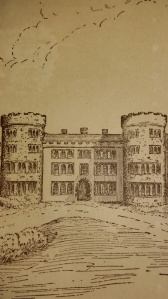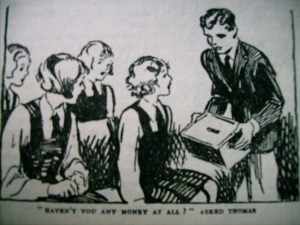 “My school,” thought Darrell, and a little warm feeling came into her heart. “It’s fine. How lucky I am to be having Malory Towers as my school-home for so many years. I shall love it.”
“My school,” thought Darrell, and a little warm feeling came into her heart. “It’s fine. How lucky I am to be having Malory Towers as my school-home for so many years. I shall love it.”
First Term at Malory Towers is the story of Darrell Rivers’ first term at Malory Towers. It was written in 1946, around the time that Enid Blyton wrote some of her best-loved fiction. Darrell arrives at Malory Towers determined to work and play as hard as she can, but she finds that it’s not as easy as that, and soon she is losing her temper and getting into trouble as well as playing pranks and having fun.
My opinon is that Enid Blyton writes some of the most realistic school stories that there are. Her characters are spot on. They aren’t as complex as some other school story writers’ characters, for example Elinor Brent-Dyer’s, but they behave just as real people do. Darrell, the heroine, is a genuinely interesting creation. At first she seems like a normal, jolly schoolgirl, excited to be going away to school and eager to be popular. It isn’t until more than a quarter of the way into the book that we, along with the rest of the characters, learn that she has a violent temper. Shortly afterwards we’re given another surprise when we find that she’s courageous enough to own up to her own greatest failing and apologise unreservedly for it. This is something she struggles with throughout her school journey, and we are eventually privileged to see her overcome it.
The plot is unremarkable, but perhaps that in itself is remarkable. There are no avalanches, snowstorms, or floods (Elinor Brent-Dyer), no secret passages or spies (Dorita Fairlie-Bruce), no fires (Angela Brazil) or sudden rises to fame (Elsie Oxenham). Instead we see a relatively small prank (Gwendoline’s ducking of Mary-Lou) blown up into an enormously important incident which results in misery for Darrell and a huge improvement on the part of Mary-Lou, not to mention unfortunate results for Gwendoline herself, all because of that young lady’s desire for revenge. The other main piece of plot, which revolves around quiet Sally Hope, is equally interesting and brings more challenges for Darrell. Her temper once again comes to the fore, and this time she isn’t so eager to put herself forward to admit her mistake and struggles to do the right thing.
Enid Blyton’s language is undeniably simplistic, but is this necessarily a bad thing? It leads to a less interesting story and means that the reader is rarely challenged (one of my favourite things about Elinor Brent-Dyer’s Chalet School series was that it constantly made me run to the dictionary to find things out), but it also makes for a nice, easy, relaxing read. And yet there’s something about Enid Blyton’s use of language – she can really tell a story. It might not be challenging but it’s interesting and gripping, and younger readers in particular simply don’t want to put it down.
So, not complex, subtle or challenging, but holding an undeniable something, Enid Blyton’s First Term at Malory Towers is definitely worth another look.


